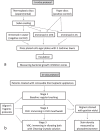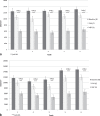Efficacy of three hygienic protocols in reducing biofilm adherence to removable thermoplastic appliance
- PMID: 23786595
- PMCID: PMC8683063
- DOI: 10.2319/012413-75.1
Efficacy of three hygienic protocols in reducing biofilm adherence to removable thermoplastic appliance
Abstract
Objectives: To examine the ability of a removable thermoplastic appliance (RTA) to adsorb hygienic solutions and inhibit bacterial growth and to examine the efficacy of three hygiene protocols in reducing bacterial biofilm adherence to RTA.
Materials and methods: Solution adsorption and bacterial growth inhibition were examined in vitro using paper vs RTA discs. Subsequently, 11 patients treated with RTA (mean age, 29.1 ± 4.7 years) were assigned into a sequence of three hygiene protocols: regular RTA brushing (baseline), immersion RTAs in chlorhexidine mouthwash (CHX), and using a vibrating bath with cleaning solution (VBC). For each patient, 12 upper RTAs were examined (2 baseline RTAs, 5 CHX RTAs, and 5 VBC RTAs), for a total of 132 RTAs. All RTAs were stained with gentian violet, and biofilm presence was measured using a photodensitometer.
Results: The RTA discs did not adsorb CHX or cleaning solution. The later agent did not show antibacterial features. Baseline RTAs showed significant biofilm adherence (P < .001) on the posterior palatal side of the aligner and on the anterior incisal edge. CHX and VBC hygienic protocols significantly (P < .001) reduced baseline biofilm adherence by 16% and 50%, respectively. Hygienic improvement was maintained over 140 days when CHX and VBC were used. However, VBC was three times more efficient than CHX.
Conclusions: This study highly recommends the use of a VBC protocol. Biofilm deposits on the RTA, especially on incisal edges and attachment dimples, could lead to inadequate tooth/RTA and attachment/RTA overlap and consequently impair tooth alignment.
Figures







Comment in
-
Re: Efficacy of three hygienic protocols in reducing biofilm adherence to removable thermoplastic appliance. The Angle Orthodontist 2014(1) 161-170.Angle Orthod. 2014 May;84(3):573. doi: 10.2319/0003-3219-84.3.573. Angle Orthod. 2014. PMID: 24749707 Free PMC article. No abstract available.
-
RE: response to: Efficacy of three hygienic protocols in reducing biofilm adherence to removable thermoplastic appliance. The Angle Orthodontist 2014(1) 161-170.Angle Orthod. 2014 May;84(3):574. doi: 10.2319/0003-3219-84.3.574. Angle Orthod. 2014. PMID: 24749708 Free PMC article. No abstract available.
References
-
- Zhang N, Bai Y, Ding X, Zhang Y. Preparation and characterization of thermoplastic materials for invisible orthodontics. Dent Mater J. 2011;30:954–959. - PubMed
-
- Schuster S, Eliades G, Zinelis S, Eliades T, Bradley TG. Structural conformation and leaching from in vitro aged and retrieved Invisalign appliances. Am J Orthod Dentofacial Orthop. 2004;126:725–728. - PubMed
-
- Eliades T, Bourauel C. Intraoral aging of orthodontic materials: the picture we miss and its clinical relevance. Am J Orthod Dentofacial Orthop. 2005;127:403–412. - PubMed
-
- Jendresen MD, Glantz PO. Clinical adhesiveness of selected dental materials: an in-vivo study. Acta Odontol Scand. 1981;39:39–45. - PubMed
Publication types
MeSH terms
Substances
LinkOut - more resources
Full Text Sources
Other Literature Sources
Medical

